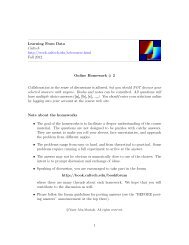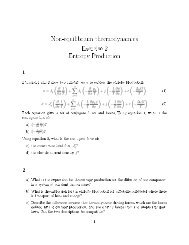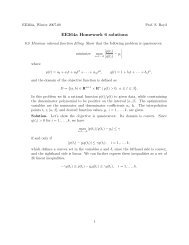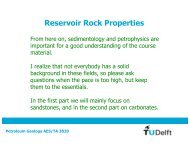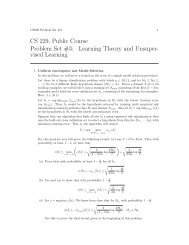Stanford CS193p
Lecture 1 Slides (September 27, 2011) - Marek Piasecki
Lecture 1 Slides (September 27, 2011) - Marek Piasecki
- No tags were found...
You also want an ePaper? Increase the reach of your titles
YUMPU automatically turns print PDFs into web optimized ePapers that Google loves.
Spaceship.h<br />
#import "Vehicle.h"<br />
#import "Planet.h"<br />
@interface Spaceship : Vehicle<br />
Objective-C<br />
#import "Spaceship.h"<br />
@interface Spaceship()<br />
// declaration of private methods (as needed)<br />
Spaceship.m<br />
// declaration of public methods<br />
@property (nonatomic) double topSpeed;<br />
@end<br />
@implementation Spaceship<br />
This is the name of the<br />
storage location to use.<br />
- (void)orbitPlanet:(Planet *)aPlanet<br />
atAltitude:(double)km;<br />
We almost always use @synthesize to create the<br />
implementation of the setter and getter for a @property.<br />
It both creates the setter and getter methods AND<br />
creates some storage to hold the value.<br />
// implementation of public and private methods<br />
@synthesize topSpeed = _topSpeed;<br />
- (void)setTopSpeed:(double)speed<br />
{<br />
???<br />
}<br />
_ (underbar) then the name of the<br />
property is a common naming convention.<br />
- (double)topSpeed<br />
{<br />
???<br />
}<br />
If we don’t use = here, @synthesize<br />
uses the name of the property<br />
(which is bad so always use =).<br />
@end<br />
- (void)orbitPlanet:(Planet *)aPlanet atAltitude:(double)km<br />
{<br />
// put the code to orbit a planet here<br />
}<br />
<strong>Stanford</strong> <strong>CS193p</strong><br />
@end<br />
Fall 2011



